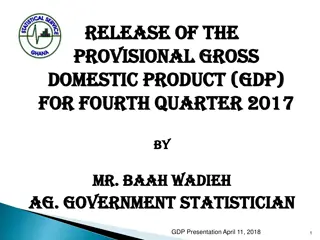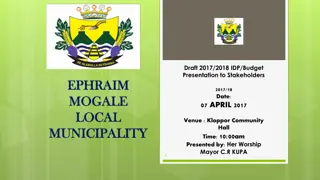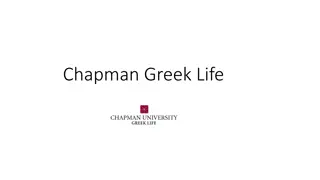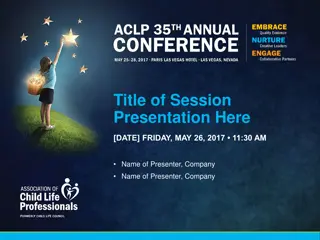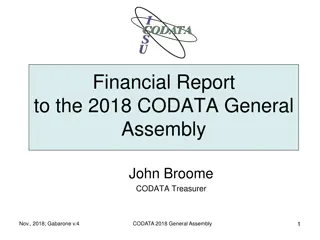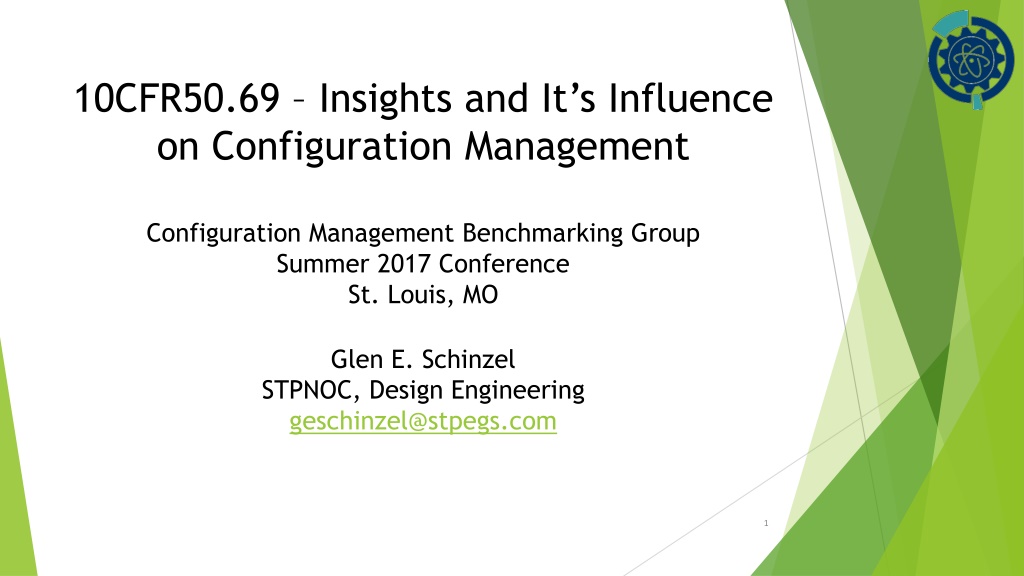
Insights into 10CFR50.69 and Configuration Management
10CFR50.69 is an important regulatory rule that offers safety and economic benefits for operating nuclear stations. This rule allows for the removal of low safety significance components from certain regulatory requirements, providing opportunities for enhanced safety and cost savings. The scoping rule of 10CFR50.69 allows licensees to adjust the scope of applicable components, with changes being voluntary. Treatment changes under this rule involve confirming adequacy for risk-significant functions and attributes. Various regulatory rules are affected by 10CFR50.69, impacting areas such as inspections, maintenance, and event reporting.
Download Presentation

Please find below an Image/Link to download the presentation.
The content on the website is provided AS IS for your information and personal use only. It may not be sold, licensed, or shared on other websites without obtaining consent from the author. If you encounter any issues during the download, it is possible that the publisher has removed the file from their server.
You are allowed to download the files provided on this website for personal or commercial use, subject to the condition that they are used lawfully. All files are the property of their respective owners.
The content on the website is provided AS IS for your information and personal use only. It may not be sold, licensed, or shared on other websites without obtaining consent from the author.
E N D
Presentation Transcript
10CFR50.69 Insights and Its Influence on Configuration Management Configuration Management Benchmarking Group Summer 2017 Conference St. Louis, MO Glen E. Schinzel STPNOC, Design Engineering geschinzel@stpegs.com 1
Overview 50.69 offers a significant strategic opportunity for current and future operating stations Enhanced safety benefits Substantial economic savings available Available during construction/startup/operational activities Benefits available for PWRs / BWRs Requires a commitment of senior leadership and staff Investment in the future viability of your station 2
10CFR50.69 Background 10CFR50.69 is an approved regulatory rule that allows safety-related SSCs determined to have Low safety significance to be removed from the scope of a number of regulatory requirements SSCs must be categorized using an NRC-approved methodology 50.69 is not a new rule Piloted by STP beginning in 2001 Rule published on 11/22/04 3
10CFR50.69 Background 10CFR50.69 is a scoping rule in that regulatory programs are NOT eliminated, but the scope of components applicable to these regulatory programs is changed Licensees can choose the degree and timing of treatment changes can select 1, 2, 5, 12, etc. systems Adoption of 10CFR50.69 is VOLUNTARY Recent economic challenges within the industry has renewed and broadened interest to consider 50.69 Delivering the Nuclear Promise Efficiency Bulletins being issued to encourage use 4
Treatment Changes RISC 1 RISC 2 Non Safety Related Safety Related Confirm treatment for beyond design basis functions Confirm treatment adequate for risk- significant attributes High Safety Significant High Safety Significant Non Safety Related Safety Related Apply Owner- Controlled Alternate Treatment No additional treatment necessary Low Safety Significant Low Safety Significant RISC 3 RISC = Risk Informed Safety Class RISC 4 5
Regulatory Rules Affected by 50.69 In-service Inspection [10 CFR 50.55a(g)] Deficiency Reporting [10 CFR Part 21] Local Leak Rate Testing [10 CFR 50 Appendix J] Quality Requirements [10 CFR 50 Appendix B] Maintenance Rule [10 CFR 50.65] Environmental Qualification [10 CFR 50.49] In-service Testing [10 CFR 50.55a(f)] Event Reporting [10 CFR 50.55(e)] Applicable Portions of IEEE standards [10 CFR 50.55a(h)] ASME XI repair & replacements, applicable portions, with limitations [10 CFR 50.55a(g)] Notification Requirements [10 CFR 50.72, 50.73] Seismic Qualification [Portions of Appendix A to 10 CFR Part 100] 6
Categorization vs. Treatment The categorization process is separate from treatment adjustments Involves different teams of personnel Only categorized systems/components are available to have alternate treatments applied All SSCs within a selected system must be categorized 50.69 eliminates many special treatment requirements for RISC-3 applications however, 50.69 also defines requirements to be applied to RISC-3 applications and for obtaining "reasonable confidence" in performance of accident function(s) 7
Keys to Successful Implementation Sponsorship from senior leaders is essential Direct reports and staff must see the commitment to make 50.69 successful Strategically determine up-front what you want to accomplish with a 50.69 implementation Verbalize clearly and translate into an effective Business Case Understand the scope and pace you wish to pursue Business Case needs to lay out a realistic schedule with supporting resources (personnel and budget) Engage affected organizations Ensure understanding and the sound basis for process changes 8
Keys to Successful Implementation Dedicate resources to support implementation A strong project manager is needed Don t rely on individual organizations getting it and self-implementing the allowances Establish milestones and indicators to reflect progress Establish clear means on defining savings Capture soft and hard dollar savings Collaborate with others No one has been perfect in the implementation to date Certain implementation aspects still need to be worked out New opportunities will be identified 9
In-Service Testing (IST) Overview Per 50.69, the scope of SSCs subject to In-service Testing (IST) requirements could be reduced for RISC-3 SSCs: MOVs, AOVs/SOVs, Check Valves, Relief Valves, Pumps For SSCs removed from scope, it is required that: Periodic inspection and testing activities be conducted to determine that these SSCs will remain capable of performing their safety-related functions under design-basis conditions 11
In-Service Testing Program Overview For STP, RISC-3 SSCs available to be removed from IST scope totaled 251 valves and 8 pumps STP initially focused on frequency extensions for RISC-3 SSCs STP performed assessments on each affected test group Basis for test group frequency extensions documented on a formal engineering evaluation approved and controlled Periodic test data collection/trending of results still occurs No increased failure rates noted based on test frequency changes 12
In-Service Testing Overview & Status With full implementation, differences in treatment for RISC-3 SSCs removed from scope vs. RISC-1 SSCs include: test frequencies extended based on past performances and reasonable confidence for successful future performance testing occurs under a Preventive Maintenance (PM) task vs a Surveillance Test (ST) trending still validates expected successful operation until the next test performance if a test fails to meet expected criteria, a Condition Report will be written rather than documenting a failed surveillance test 13
Regulatory Inservice Testing vs. RI-IST Licensees can still pursue a Risk-Informed IST (RI-IST) program in addition to 50.69 Graded approach can be applied to those SSCs remaining within the regulatory IST scope At STP, for those SSCs still within the regulatory IST scope (RISC- 1), the additional opportunity includes: 178 valves and 7 pumps that could be determined to be RI-IST Low and could have their frequency of testing extended 14
Local Leak-rate Testing Overview Per 50.69, Type B and Type C Local Leak Rate Testing (LLRT) is not required for safety-related valves determined to be RISC-3 and that satisfy one or more of the following criteria: Containment penetrations are 1 in size or less, or are continuously pressurized (Type B) valve is open with mass flow during accident scenarios valve is normally closed in a closed water-filled system valve is in a closed piping system which has a crush pressure greater than that of Containment and is not connected to the RCS the valve is 1 in size or smaller 15
STP Local Leak-rate Testing Implementation LLRT Program procedure modified to reflect scope adjustment Each penetration which contained RISC-3 valves was evaluated against scoping criteria Evaluation results documented on a formal engineering evaluation approved and controlled For valves that satisfy scoping criteria, annotated that LLRTs are no longer required in the Surveillance database Training provided to Performance Techs and Operations 16
STP Local Leak-rate Testing Implementation 43 penetrations were removed from regulatory-required Type C LLRT testing scope reduced by 57% - also applied insights to Integrated Leak-Rate Test in Unit 2 LLRTs may still be performed if deemed prudent to perform the test LLRT STs have not been deleted - frequency of performance changed to an Inactive status No substantive performance degradation has been noted to date due to reduced scope of LLRT testing 17
Parts Procurement Approach at STP RISC-3 replacement parts are assessed on an as-needed basis - no large-scale procurement approach pursued Evaluations are initiated by Procurement personnel and forwarded to Procurement Engineering for evaluation Procurement personnel provide the initial screening for potential to exercise the Exemption allowances If industrial part is available and appears economically beneficial, a Condition Report is generated for Procurement Engineering to evaluate the acceptability of the proposed industrial part 18
STP Parts Procurement Overview Examples of industrial parts that have been installed in RISC-3 applications: Spent Fuel Pool Heat Exchanger discharge valve flow guide Radiation Monitor sample pumps Safety-related vent and drain valves HVAC analog-to-digital flow controller change out Capacitors on computer card rebuilds No adverse performance trends noted to date for industrial parts in RISC-3 applications No adverse warehousing issues noted to date with RISC-3 industrial parts 19
Insights on STP Parts Procurement Available safety-related stock in the warehouse must be depleted before actual use of commercial replacement parts are considered Delay in actual recognition of parts savings Could assess warehousing approach for RISC-3 SSCs Some potential commercial part replacements are not economically viable - in these cases, safety-related parts continue to be procured and installed Cultural issues need to be overcome in Engineering, Procurement, and Maintenance organizations 20
STP Maintenance Rule Approach RISC-3 SSCs can be removed from the scope of 10CFR 50.65 (but not (a)(4)) For each MR-scoped system where the entire system is RISC-3 or RISC-4, the system is removed from MR scoping Some significant MRFF contributors have been removed from scope Radiation Monitoring, Emergency DC Lighting In addition, STP has made the business decision that if a system is plant generation significant, it will be administratively tracked against the Maintenance Rule failures not counted as MRFFs 21
Environmental Qualification Overview Per 50.69, the scope of RISC-3 SSCs subjected to 10CFR 50.49 requirements can be reduced Qualification requirements imposed under 50.49 not required Design functional requirements still need to be satisfied; however, the rigor required to meet this is reduced (i.e., qualification testing, test report generation/retention, etc.) Can take credit for current qualified conditions Qualified life extensions much more straight-forward 22
STP Environmental Qualification Approach STP s initial EQ Program included 2,533 SSCs: 1931 of these SSCs were determined to be RISC-3 Total number of SSCs in EQ Program is now 602 (a reduction of 76%) Implementation benefits take a number of forms: Qualified life extensions using formal engineering evaluation Commercial parts procurements Reduction in testing rigor Reduction in test report processing 23
Tool-Pouch Maintenance Overview Tool-Pouch Maintenance (TPM) is a means of resolving simple deficiencies which are within the skill sets of the available craftsmen no documented work planning is needed no work implementation scheduling is needed TPM process is procedurally controlled TPM process permits minor deficiencies on RISC-3 SSCs to be corrected in an expedited fashion safety benefit to restore RISC-3 SSCs to a reliable, fully-functional condition 24
Tool-Pouch Maintenance Overview, Status Procedures modified to permit use of TPM on RISC-3 SSCs TPM previously was only permitted on non-safety related SSCs A Condition Report is still generated to document the RISC-3 SSC deficiency The craftsman documents the correction electronically in the CAP database - no paperwork generated or vaulted PMTs are still performed, if required, to validate that the SSC is satisfying its design functional requirement Since revision of the TPM procedures, no adverse SSC performance trends have been attributed to TPM implementation 25
Additional Uses of Categorization Insights Categorization insights afford many opportunities to enhance station decision-making other uses include: Strategically determining which design changes should be prioritized for safety enhancements Preventive Maintenance optimization efforts to revise scopes and frequencies of performance Used as a risk-informed evaluation process to establish what constitutes covered work within the NRC Work-Hour Rule System Engineering Health Report focus Corrective Action Program apparent cause and root cause evaluation criteria 26
STP Implementation Overview STP chose to pursue a cautious, deliberate implementation approach Based on stakeholder support and available baseline resources, STP pursued program and process changes in the following areas first: IST (10CFR 50.55a(f)) LLRT (Appendix J) Parts procurement (Appendix B, 10CFR 50.49) Tool-Pouch Maintenance (Appendix B) Maintenance Rule (10CFR 50.65) 27
STP Implementation Process Periodic feedback to the IDP is important to ensure that categorization results remain well founded and defensible A periodic assessment is done of all categorized systems once every three years looks at overall equipment performance changes (operating experience trends) PRA Model updates are communicated to the IDP main driver for categorization changes System Engineer feedback is provided to overview changes to system health Feedback is gathered from Operations, Licensing, and Quality for changes to procedures and processes that might affect categorization outcomes 28
Keys to Successful Implementation View implementation as a key ingredient to station survival 50.69 definitely reduces regulatory burden Enhances nuclear safety while reducing costs Permits more effective ways of accomplishing change Adds efficiency into well-established processes 29

